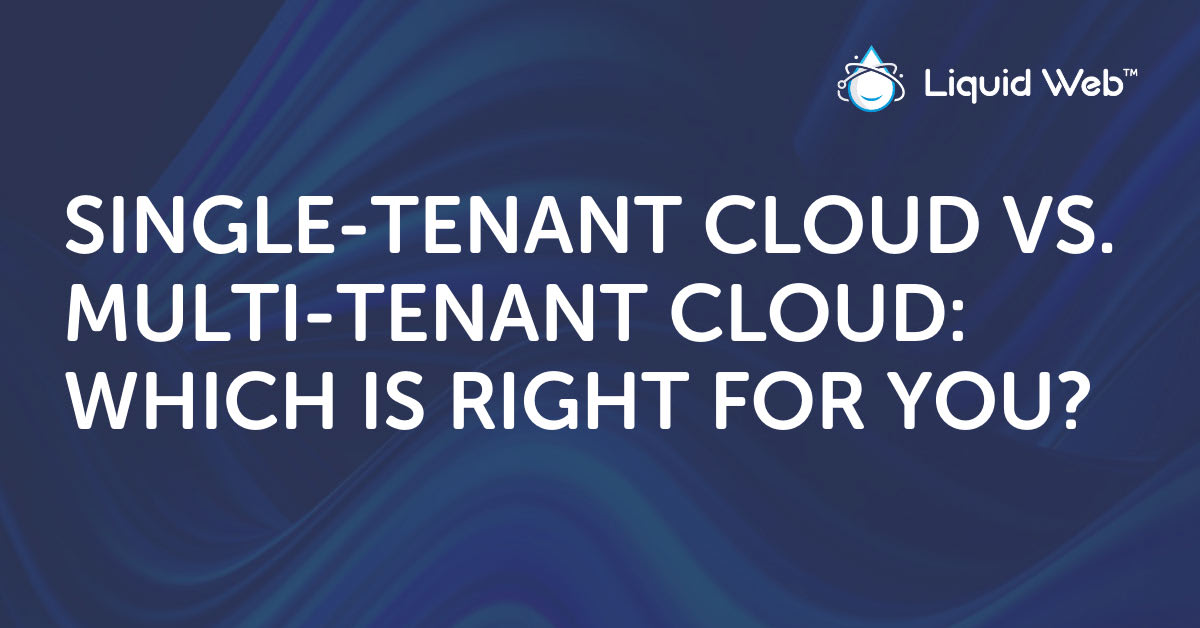
Interested in moving to cloud computing but unsure whether single-tenant cloud vs multi-tenant cloud is right for you?
Cloud computing is the delivery of on-demand computing services. The cloud has created an information technology revolution in the last decade. More and more workloads have been moved off of traditional hosting infrastructure to the cloud, leading many organizations to rely on the cloud entirely for their infrastructure needs.
Even if you are moving your deployments to the cloud, there are still a number of things to consider as not all cloud instances are created equal.
For instance, you might consider:
There are indeed countless variations and configurations of the cloud that must be sorted out during any digital transformation. Finding out which of the managed cloud solutions is your best choice is the number one priority.
When it comes to running an application, one of the most common decisions we see by businesses and developers is whether to opt for a single-tenant or multi-tenant environment. In this piece, we will detail the difference between single-tenancy and multi-tenancy and examine the benefits and drawbacks of each.
Single-Tenant Cloud
A single-tenant environment occurs when a single instance of the software application runs on a single infrastructure instance to serve a single customer. Think of single-tenancy as the entire experience for a customer, client, or user, being served without sharing resources, storage space, or even connectivity.
Single-tenancy application models most commonly occur in SaaS environments (Software-as-a-Service provided on-demand and hosted elsewhere) when the application provider offers a customer both software and infrastructure working in concert. In this model, the SaaS has responsibility for both the software and the infrastructure, ensuring that they work well and work together, much to the user’s or customer’s delight.
Benefits of a Single-Tenant Cloud
Single-tenant environments are great if the user or application requires customizations for their own use case. Because no resources or code is being shared within the tenancy, modifications can be made to both infrastructure and application to fit the particular user’s or customer’s needs. Many individuals and companies choose single-tenancy for the flexibility offered for application and infrastructure alike.
Additional benefits from single-tenant environments relate to data. In a single-tenant environment, data is inherently better protected because it’s all stored securely in a single place without other users lurking around. Additionally, backups, restorations, and migrations tend to be simpler in a single-tenant environment because data and files are distributed in multiple locations.
Drawbacks of a Single-Tenant Cloud
The drawbacks of a single-tenant system can largely be divided into two groups:
In a single-tenant environment, the fact that there are no other users or applications using the infrastructure means that the entire cost burden falls to a single entity or organization.
Additionally, provisioning and managing a single-tenancy is more expensive than simply adding users or applications to a multi-tenant environment.
Regarding utilization and optimization, it is common for single-tenant environments to be less efficient than multi-tenant counterparts from a resource allocation standpoint. Even though the cloud is designed to offer “…as-a-Service” and a per-use cost system in many cases, a single-tenant environment doesn’t behave the same way. If only one user or application is in a tenancy, it won’t make sense to redact or remove resources not in use; the whole environment might accidentally disappear. That means that single-tenant users, almost by definition, will pay for resources they don’t need or aren’t using at any given moment.
Multi-Tenant Cloud
Unlike a single-tenant environment, a multi-tenant cloud allows many users or customers to share resources of infrastructure. The users are logically isolated so that their data and usage don’t overlap, but the software and infrastructure serve them all. This is an efficient way to deliver software to users but also comes with some limitations.
Benefits of a Multi-Tenant Cloud
The benefits of a multi-tenancy environment come down to scalability and efficiency. By deploying a multi-tenant cloud for your application, you have the advantage of being able to add more users or customers without spinning up a new cloud instance for each one. This means that not only does your business can grow, but that your maintenance and security costs are more efficient as related to utilization.
Multi-tenant environments also allow for upkeep and updates to be handled all-for-one. Your managed provider or IT team can patch and update components and software all at once for the benefit of all users instead of performing maintenance and upgrades on a large number of single-tenant instances.
Drawbacks of a Multi-Tenant Cloud
While multi-tenant cloud infrastructure can be a great choice, it is not without its drawbacks.
The most glaring downside of this architecture is significantly limited flexibility and agility. Because any change in the environment will affect all users, customizing the application, the infrastructure, or any associated integrations affects everyone.
Oftentimes, customers are willing to pay more for these special considerations or customizations. If your application is deployed in a multi-tenant environment, your ability to meet their needs will be severely affected.
Additionally, even though customer data and files are separated within the environment, the fact that they are sharing resources to some degree DOES create a non-zero chance of data breach or corruption.

Choosing What Is Right for You
There are several things to consider when it comes to choosing the type of environment or managed enterprise hosting for your application or users.
Whether to use a single-tenancy environment or multi-tenant setup will depend on factors like cost, how customized the application needs to be for each user, and who will be managing the infrastructure and keeping it secure.
Single-tenant environments are indeed more flexible but bring additional costs. Multi-tenant environments work well for serving the most users most efficiently, but there are some tradeoffs with what you can do at both the software and infrastructure level.
When deciding what is right for your needs, think not only about the present needs but also what your needs will look like in the future. Planning for growth is a great way to right-size your infrastructure for the long-term while avoiding making a decision that could haunt you later.
Making the Cloud Work for You
Choosing the right cloud environment for your application or workloads can be confusing.
- Do you choose public cloud or private cloud?
- Which provider do you choose?
- What type of database, storage, and web server is right for you?
It can all seem overwhelming. Despite the difficulty, however, you must choose the right cloud environment to get the best performance and maximum return on investment for your spending.
Choosing between a single-tenant or multi-tenant cloud environment is one of the most critical cloud decisions you can make. Our team at Liquid Web has years of experience not just providing class-leading VPS and dedicated servers but also in designing and deploying dedicated cloud hosting environments. From small and mid-sized businesses to multinational enterprises, our team of the Most Helpful Humans in Hosting can help with your infrastructure needs. Contact us to learn more about how Liquid Web can help make the cloud work for you.
Related Articles
[ad_2]
Source link







